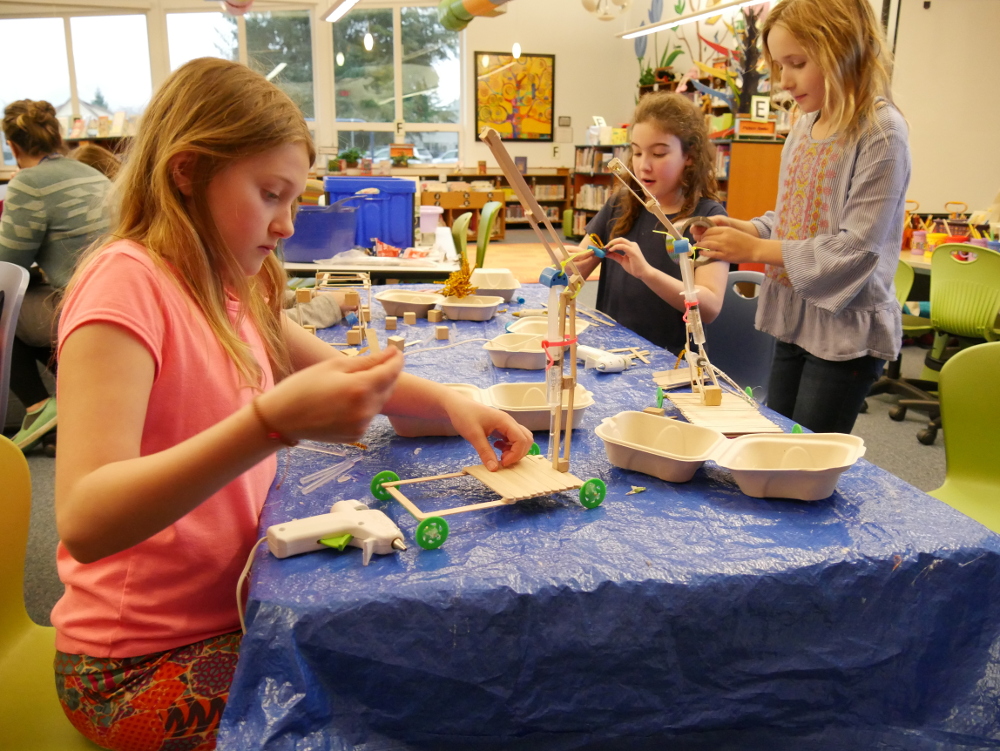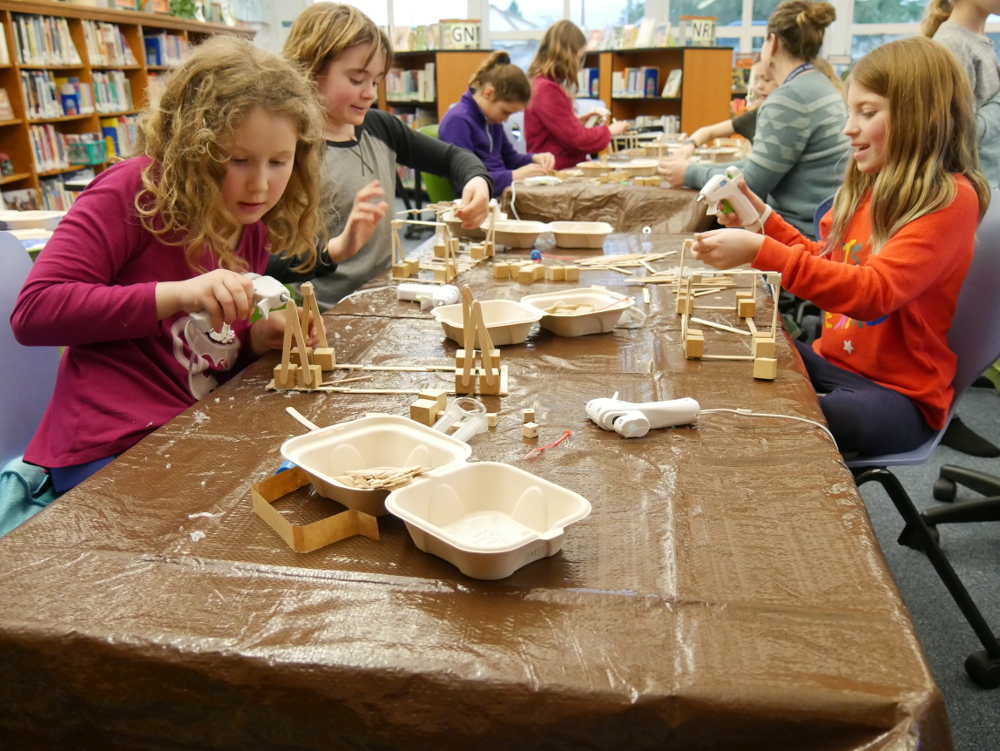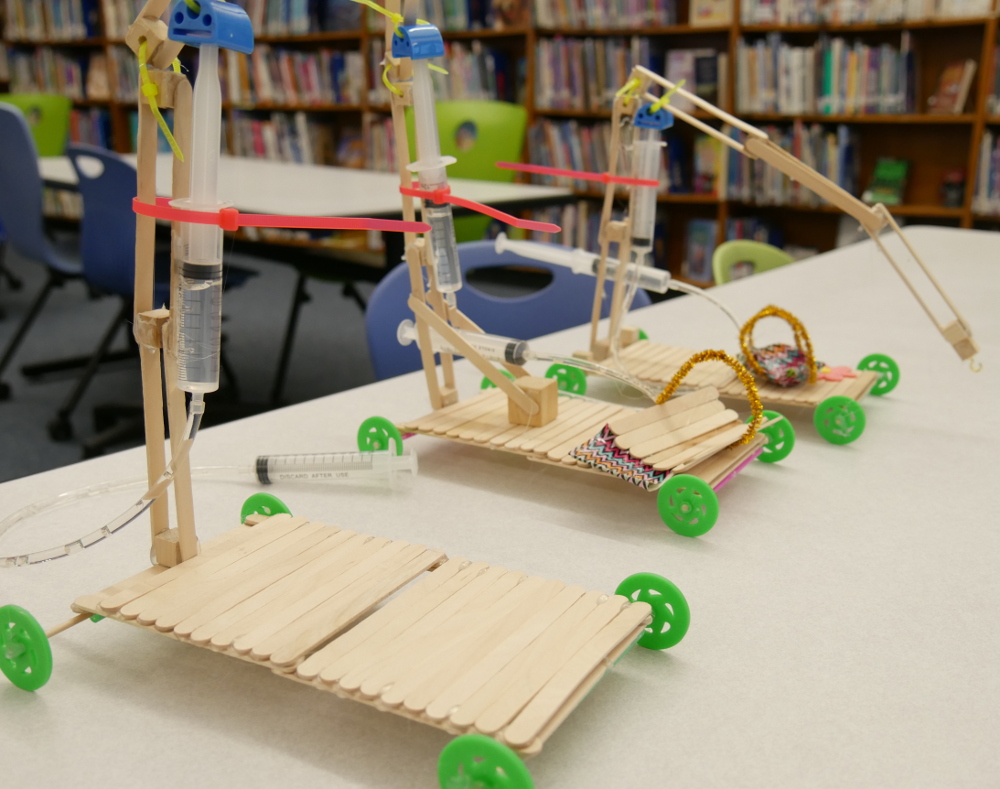
A dedicated group of girls is spending their Wednesday afternoons at Stedman Elementary School in Petersburg building robots, hydraulic machines and learning to code. The club is one of several that have formed in Southeast Alaska to develop the next generation of women in computer science jobs using the curriculum from a national organization.
Even before the end of classes on Wednesdays, 3rd, 4th and 5th grade girls start filtering into the elementary library, drop their backpacks and sit down, focused on making progress on a project. Some are finishing up a hydraulic arm from last week, most are using a hot glue gun to attach wooden parts.
“I just need to put my hook so then when you pull one syringe and it’s connected to another it would lower the arm, so it can hook up whatever you want to hook,” said Madelyn Dreisbach. “But my friend Emi put a little bit of magnet under the hook so that it would be magnet and a hook. So I did the same thing. I just have to glue it on and then my hydraulic arm would be finished.”
“Hi I’m Emi and right now I’m working on a hydraulic bridge,” said her friend Emi Anderson nearby. “And so the hydraulic bridge is supposed to lift up when you press on one of the syringes and the water in the syringe, there’s a straw that connects them, the water goes through to the other syringe and it pushes up the bridge.”
“The steps to making a hydraulic bridge is you make a structure,” explained Jillian Versteeg. “So the first part you do is you make a rectangle out of popsicle sticks and the you add cubes on all four sides and then you add a popsicle stick on the outside.
Nearby is another student, Bella Miller, hard at work. “I’m working on a hydraulic bridge which is basically a bridge that is powered by water of course,” Miller said. “And in the syringe, you fill it up with water and when you, I believe, go out the bridge comes up and when you go in the bridge comes in.”

The club’s leader is parent Kellii Wood. She’s a biologist with the Alaska Department of Fish and Game and uses coding in her work. Wood was looking for activities for her daughters and came across a TED talk by the founder of the national organization Girls Who Code. She’s been using that group’s free curriculum that runs for 5-10 weeks, but Wood has extended the program beyond that.
“I wanted these girls to bond and feel like you can’t do that in a short amount of time,” Wood said. “So I’m hoping, I wanted to take this to the end of the school year. So now we’re doing more engineering projects. So we’ve been building some basic robots, with the goal in mind that somehow we can merge coding and robotics and we’re also doing some other engineering projects.”
Projects earlier in the school year covered basic wiring and coding an animated video using computer software. Future topics could include building basic computer boards, solar panels and even basic rocketry. Wood creates each project with her eldest daughter Kaija at home beforehand.
“I really like it,” her daughter said of the club. “I like doing hands on activities because we get to do a lot of creativity.”
The Girls Who Code organization was formed to encourage more women in computer science jobs. Nationally, it says the gender gap in that field is getting worse. 37 percent of computer scientists were women in 1995 but that had dropped to 24 percent in 2017. Why are fewer girls seeking that as a career? Wood has some thoughts from the elementary schoolers she’s worked with.
“Self confidence is a huge important part of it, supporting each other,” Wood said. “I think having an all-girls club makes it really helpful in that they feel safe and they can ask those questions and they don’t feel judged. And I put them through the wringer with some of these projects, they’re hard and that’s part of it because I’m trying to teach them perseverance and grit and that’s something that will get them through life, if anything. Even if they don’t go through coding. This is going to help them work hard to get a good reward. And you can see it. There will be tears. They get so frustrated some times but in the end when it works their faces light up and they get really excited and they can’t wait to show it off.”
Wood has 17 girls signed up this year and they’ve all been sticking with the program since it began in October. The national organization provides a grant of 300 dollars a year to pay for some of the supplies. Wood donates other needed material. Computer software is free and the local club also uses a lot of recycled goods for projects.
She’s keeping this program going through the end of the school year and hopes it will continue into next year and possibly expand into the middle school. She’s also excited to see other groups have started up in Wrangell and Ketchikan.












